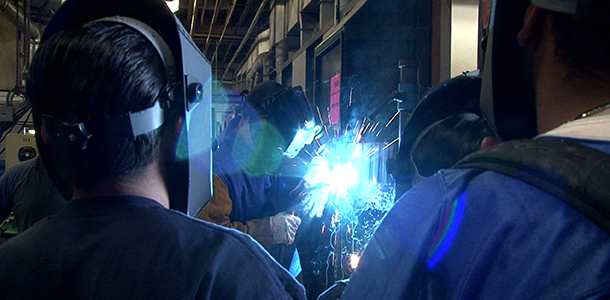
(Photo Credit: John Guenther/CA Fwd)
Gov. Jerry Brown proposed spending more than $270 million on improving the performance of California’s workforce training programs in his proposed budget yesterday, providing a boost to the California Economic Summit’s efforts to strengthen regional workforce pipelines—and better connect training programs with the needs of employers.
For the last three years, the Summit has supported increased investment in career technical education (CTE) programs—and pushed the state to allocate these funds across regional economies and industry clusters, instead of diffusing them among all community colleges. The goal has been to connect more workers with well-paying jobs by promoting collaboration between employers and regions’ vast network of workforce training programs, from K-12 schools and community colleges to workforce investment boards and community-based organizations.
In his proposed budget, the governor has embraced this approach, setting aside $200 million for a new, ongoing program that aims to do just that. The governor’s “Strong Workforce Program” is intended to allow community colleges to expand access to career technical education courses and programs, while implementing a new regional accountability structure recommended by the 2015 Community College Board of Governors Task Force on Workforce, Job Creation, and a Strong Economy.
The budget also includes another Task Force proposal, committing $48 million annually to an existing career technical education program pathways program that has increased collaboration between K-12 schools and community colleges. The Summit supported this investment when it was first made in 2012, and the governor wants to make the program permanent.
Several Summit leaders served on last year’s Task Force, contributing ideas during its deliberations and supporting its final recommendations in September. In the 2016 Roadmap to Shared Prosperity, which will be released next week, the Summit will outline its plans to support the formation of regional civic organizations in several regions to accelerate the Task Force’s recommendations—and to increase alignment of workforce development programs and employers.
“This budget truly heeds the call for strengthening the workforce pipeline in our regional economies,” says Alma Salazar, vice president of education and workforce development at the Los Angeles Area Chamber of Commerce, who also serves as a co-lead of the Summit Workforce Action Team. “We commend the Governor for creating a better environment for workforce training in California, and the Summit will push to seek them enacted in the final budget.”
Before the final budget deal is reached, the governor has also proposed resurrecting another workforce program supported by the Summit, providing $25 million to the Awards for Innovation in Higher Education. This $50 million grant program, first approved in the 2014 budget, was intended to support efforts on college campuses to expand access, improve quality, and integrate programs in a meaningful way. The Summit and its partners co-hosted the first-ever California Awards for Innovation in Higher Education Showcase in 2015. More than 50 campuses submitted applications, and 33 schools presented innovations aimed at supporting students and collaborating across sectors to improve completion rates and workforce preparation. This summer, fourteen campuses were awarded grants.

